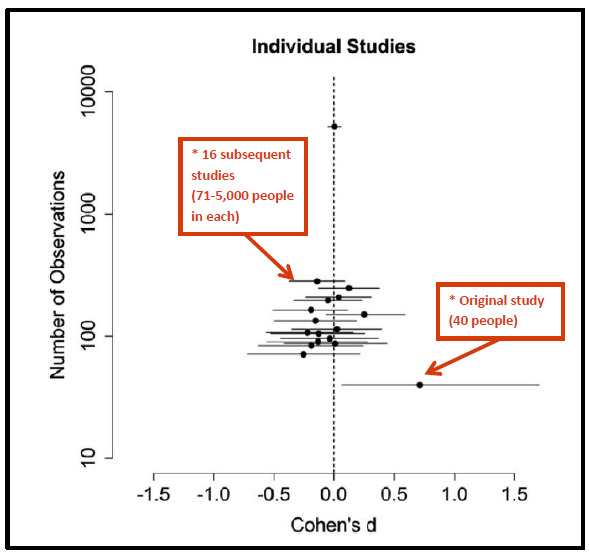Rather, my message is that this noisy, N = 41, between-person study never had a chance. The researchers presumably thought they were doing solid science, but actually they’re trying to use a bathroom scale to weigh a feather—and the feather is resting loosely in the pouch of a kangaroo that is vigorously jumping up and down.
Andrew Gelman critiquing a Kahneman psychology study. Via one of my favorite blogs.
Health, psychology, and exercise studies are, in my experience, the worst kangaroo-jumping feather-weighers.
One of the most important things you can do as a consumer of science is also the simplest: check the N. If you are reading a peppy New York Times study about how coffee makes you live longer, or exercise doesn’t help you lose weight, more often than not the study had 30 subjects and you can simply ignore the information you just received.
If you want to go a little bit further, you could also say “is this the only outcome I care about?”



53 Responses
. If you are reading a peppy New York Times study about how coffee makes you live longer, or exercise doesn’t help you lose weight, more often than not the study had 30 subjects and you can simply ignore the information you just received.
golu dolls
golu dolls
This is how to recognize bad science https://t.co/1dtG0sQ8Q5
RT @fp2p: How to recognize bad science. First, check the N. So glad @cblatts is still blogging https://t.co/bQdploD2wr https://t.co/OaABzGL…
RT @cblatts: This is how to recognize bad science https://t.co/em6Ge9P0fN
RT @StabilitasV: #BadScience = low sample sizes = “trying to use a bathroom scale to weigh a feather”
https://t.co/tJr6VF6bsL https://t.c…
RT @NormaPadron_: “[..] this noisy, N = 41, between-person study never had a chance”
This is how to recognize bad science
https://t.co/cxc…
This is how to recognize bad science https://t.co/pfqkCOljO5
#BadScience = low sample sizes = “trying to use a bathroom scale to weigh a feather”
https://t.co/tJr6VF6bsL https://t.co/F5sz6IkJo3
RT @NormaPadron_: “[..] this noisy, N = 41, between-person study never had a chance”
This is how to recognize bad science
https://t.co/cxc…
This is how to recognize bad science https://t.co/ctqddTpEKG
“[..] this noisy, N = 41, between-person study never had a chance”
This is how to recognize bad science
https://t.co/cxcNxgN4tf
RT @fp2p: How to recognize bad science. First, check the N. So glad @cblatts is still blogging https://t.co/bQdploD2wr https://t.co/OaABzGL…
RT @cblatts: This is how to recognize bad science https://t.co/em6Ge9P0fN
This is how to recognize bad #science https://t.co/hxuEzfvLN5 https://t.co/hxuEzfvLN5
CHECK THE N! a lovely methods takedown from @statmodeling https://t.co/hBLi8HDg4a
RT @fp2p: How to recognize bad science. First, check the N. So glad @cblatts is still blogging https://t.co/bQdploD2wr https://t.co/OaABzGL…
“One of the most important things you can do as a consumer of science is also the simplest: check the N.” https://t.co/pncVBwVsrd #scicomm
RT @fp2p: How to recognize bad science. First, check the N. So glad @cblatts is still blogging https://t.co/bQdploD2wr https://t.co/OaABzGL…
RT @fp2p: How to recognize bad science. First, check the N. So glad @cblatts is still blogging https://t.co/bQdploD2wr https://t.co/OaABzGL…
RT @fp2p: How to recognize bad science. First, check the N. So glad @cblatts is still blogging https://t.co/bQdploD2wr https://t.co/OaABzGL…
RT @fp2p: How to recognize bad science. First, check the N. So glad @cblatts is still blogging https://t.co/bQdploD2wr https://t.co/OaABzGL…
RT @fp2p: How to recognize bad science. First, check the N. So glad @cblatts is still blogging https://t.co/bQdploD2wr https://t.co/OaABzGL…
How to recognize bad science. First, check the N. So glad @cblatts is still blogging https://t.co/bQdploD2wr https://t.co/OaABzGLJQY
RT @LariHokkanen: This is how to recognize bad science https://t.co/GeVmkZfni9
Came here to say the same thing as John. Misleading description to call this a “Kahneman psychology study.”
Moreover, if you only compare with zero treatment, opportunity cost is not taken into account. https://t.co/zt92mJDXl7
And combine this with publication bias (only articles with results get published) https://t.co/zt92mJDXl7
This is how to recognize bad science – Chris Blattman https://t.co/zt92mJDXl7
@cblatts: “One of the most important things you can do as a consumer of science is also the simplest… check the N” ➡ https://t.co/iIMhjvNheq
Chris, Kahneman had no part in the study that Gelman and others have criticized.
The study in question is part of Alter et al. 2008 (https://www.gsb.stanford.edu/sites/default/files/documents/mktg_10_08_alter1.pdf). Kahneman described it in his book (page 65), and he was much too willing to take it at face value. But the study isn’t a “Kahneman psychology study.”
This is how to recognize bad science https://t.co/xnXfrJ6gPc
RT @cblatts: This is how to recognize bad science https://t.co/em6Ge9P0fN
This is how to recognize bad science https://t.co/5GTrjnpt62
This is how to recognize bad science – Chris Blattman https://t.co/u2ZrzY33xh
RT @cblatts: This is how to recognize bad science https://t.co/em6Ge9P0fN
This is how to recognize bad science https://t.co/GeVmkZfni9
RT @cblatts: This is how to recognize bad science https://t.co/em6Ge9P0fN
RT @cblatts: This is how to recognize bad science https://t.co/em6Ge9P0fN
RT @cblatts: This is how to recognize bad science https://t.co/em6Ge9P0fN
This is how to recognize bad science https://t.co/qFVt3vwZMg
RT @cblatts: This is how to recognize bad science https://t.co/em6Ge9P0fN
RT @cblatts: This is how to recognize bad science https://t.co/em6Ge9P0fN
RT @cblatts: This is how to recognize bad science https://t.co/em6Ge9P0fN
RT @cblatts: This is how to recognize bad science https://t.co/em6Ge9P0fN
RT @cblatts: This is how to recognize bad science https://t.co/em6Ge9P0fN
RT @cblatts: This is how to recognize bad science https://t.co/em6Ge9P0fN
RT @cblatts: This is how to recognize bad science https://t.co/em6Ge9P0fN
RT @cblatts: This is how to recognize bad science https://t.co/em6Ge9P0fN
This is how to recognize bad science https://t.co/KAgQGYgevD
RT @cblatts: This is how to recognize bad science https://t.co/em6Ge9P0fN
RT @cblatts: This is how to recognize bad science https://t.co/em6Ge9P0fN
RT @cblatts: This is how to recognize bad science https://t.co/em6Ge9P0fN
RT @cblatts: This is how to recognize bad science https://t.co/em6Ge9P0fN